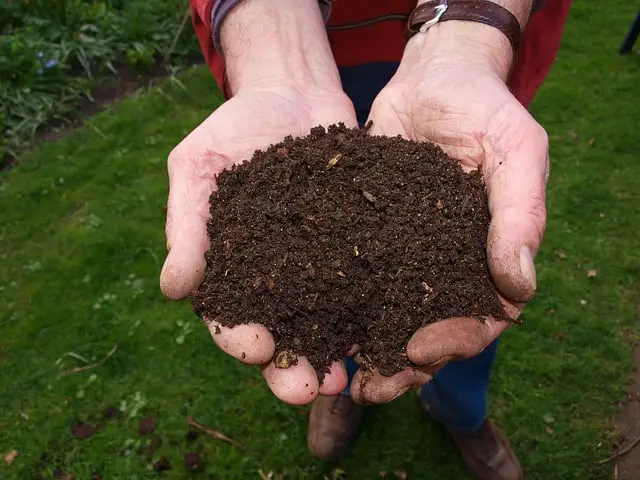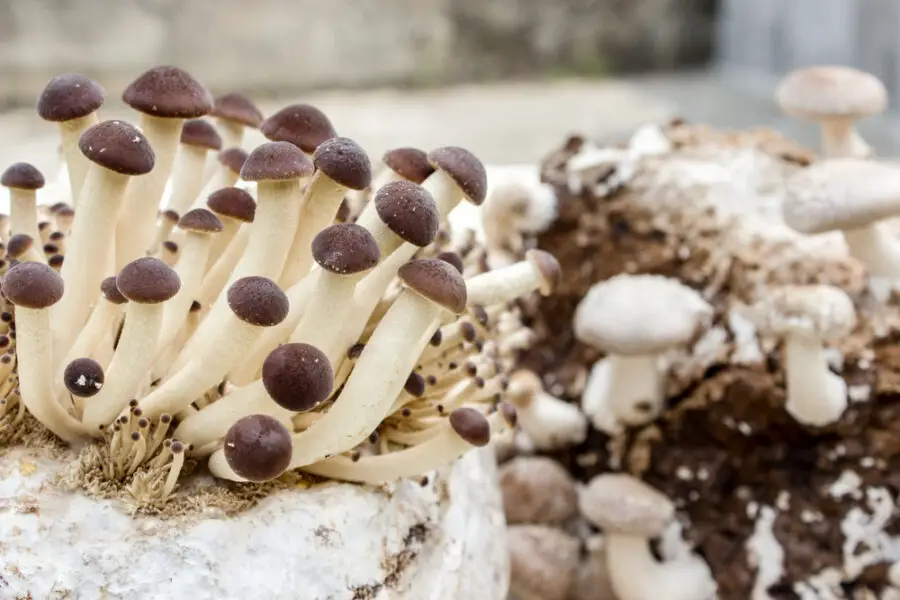Depending on the variety of mushrooms in your kit, you can expect it to regrow up to five flushes, or rounds of fruit production… but that doesn’t have to be the end of its life! With a little effort, you can regrow the entire kit from the mycelium block by sterilizing the mycelium to prevent contamination, breaking it up, and hydrating it in a fresh substrate.
The rest of this article will give details on encouraging your mushroom kit to grow fruit again, which kit varieties produce the most flushes of fruit, how to care for your mushroom kit in between fruitings, how to tell when your mushroom kit will no longer produce, and options for regrowing a mycelium that has used up the substrate that came with the kit.
Which Mushroom Varieties are Likely to Regrow More Fruit?
Here are some popular varieties of mushrooms and how many flushes you can expect from them per kit:
- Pink Oyster 2-3
- Shiitake 3-5
- Reishi 1-3
- Golden Oyster 3-5
- Lion’s mane 1-2
- Blue Oyster 2-3
- Maitake (Hen of the Woods) 2-5
- Pearl Oyster 2-4
What Can I Do to Ensure a Second Flush?
Taking excellent care of your kit according to the directions is the best way to ensure second and subsequent fruiting. Don’t let the block of substrate dry out, give it enough humidity, light, and airflow to keep the mycelium healthy, and give the mycelium a little scrape with a spoon or knife to encourage it to start “pinning,” or growing immature mushrooms.
Does My Mycelium Need to Rest?
If your mushroom kit produced a very large crop of fruit, it may be advised to let your mycelium rest in between fruitings to encourage it to produce more. Some varieties require a rest of 2-3 weeks, while others just need a day or two with a temperature change before rehydrating it and preparing it to produce more fruit.
How Can I Tell If the Kit is Done Making More Mushrooms?
If you have been taking care of your mushroom kit according to directions, it has been more than two weeks since the last harvest, and there are no signs of new primordia growth or “pinning” indicating the start of another fruiting cycle, the kit is done. Regrowing your mushroom kit is possible, but you will need a fresh substrate to nourish the mycelium.
Should I Throw Away My Mushroom Kit when It’s Done?
No! You can see if the mycelium is still alive and would grow on a fresh substrate, or reuse the block as valuable mushroom compost. The substrate block can be crumbled up and used as compost for plants that would benefit from its water-retaining properties, such as ferns, Boston ivy, or Easter lilies.
How Do I Grow the Mycelium on Another Substrate?
Once your mycelium has consumed all the nutrients in the substrate that came with the kit, you can try to regrow it by giving it some fresh substrate. Not all varieties can be regrown this way, but it’s worth a try to get even more fruit out of a single kit.
After harvesting the final flush:
- Weigh your mycelium block
- Sterilize the outside of the mycelium block with limewater or hydrogen peroxide
- Break up the block into a container such as a plastic lidded tub or 5-gallon bucket
- Multiply the mycelium block weight by 4 to determine the amount of dry substrate needed
- Add substrate preferred by your mushroom variety
- Mix and hydrate the new mushroom kit
Do I Need to Regrow my Mushroom Kit in a Tub or Bucket?
No, using the directions listed above you can regrow your kit in a bag, a wicker basket, or even a plastic laundry basket! What’s important is that the mycelium receives the humidity, temperature, light, air, and correct substrate material in order to grow and produce delicious fruit.
Will My Log Kit Regrow?
Log mushroom kits need a few months to establish but will regrow fruit for 3-6 years with proper care. If the mycelium is still alive when the log substrate is exhausted, you can follow the same directions listed above and try to grow it on a bed of wood chips or attempt to inoculate another log by drilling several holes and placing chunks of the sterilized mycelium in them.
Can I Keep Regrowing a Mushroom Kit Forever?
No, a mycelium ages just like all other biological organisms. Eventually, the mycelium will be too old to continue inoculating new substrates, and you will have to introduce new spores or buy a new kit.
Can I Try to Grow an Indoor Kit Outdoors?
Yes, many people have had success at creating a patch of mushrooms in their yard from a spent kit by digging a hole in a shaded and moist microclimate in the yard and burying the entire mycelium block. Cover the area with some mulch, and check for new mushroom growth in a few months.
Not all mushroom varieties will tolerate being moved outdoors, especially if your climate isn’t compatible with the type you chose. If it doesn’t work, there’s still a benefit because you just put fresh mushroom compost into the ground to fertilize your yard.
Can I Regrow Two Different Mushroom Types in the Same Container/Plot?
You can try, but it’s unlikely to work because different mushroom varieties will compete with one another for resources and nutrients. To maximize the amount of fruit and the health of your mushrooms, it is best to give each variety its own space.
Will an Outdoor Grow Kit Regrow?
Outdoor grow kits are a great investment because, once they are established, mushrooms will regrow year after year, seasonally, without having to introduce more spores. These kits require a plot, such as a section of a raised garden bed, and some people have reported morel mushrooms still growing from their kit 25 years later!
Hi, I’m John Stephens, chief editor and writer for Totalgardener.com. I’ve been gardening and raising animals for over 15 years starting with a small backyard plot in Northern Virginia where I grew corn, potatoes, squash, and using a high mulch technique called the Ruth Stout Method. I also raised ducks and small mammals for meat and eggs in a movable pen similar to the ones used by Joel Salatin. I later moved to Colorado where I experimented with growing greens using aquaponics inside. I eventually added a microgreens setup and home sprouting operation. I’m excited to share everything I’ve learned plus more from the other local gardening and animal raising experts I know.



